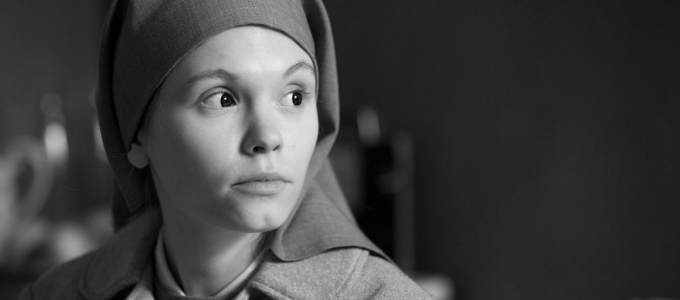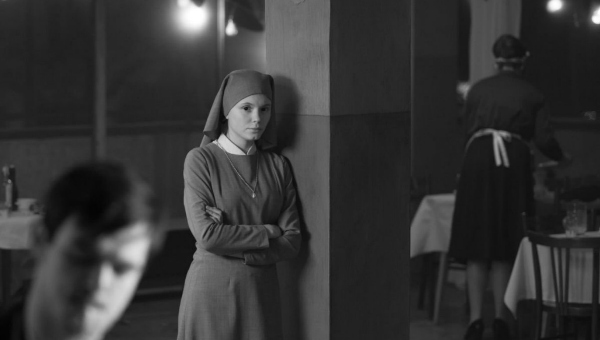 The opening shot of IDA – a young nun lightly brushing a statue of Jesus – is so visually sumptuous it could have been lifted from portraiture. Arresting from the first frame, the award-laden IDA is director Pawel Pawlikowski’s tenth film and his finest.
The opening shot of IDA – a young nun lightly brushing a statue of Jesus – is so visually sumptuous it could have been lifted from portraiture. Arresting from the first frame, the award-laden IDA is director Pawel Pawlikowski’s tenth film and his finest.
Set in Pawlikowski’s native Poland in the early 1960s, the film tells the story of an orphaned novitiate named Anna (portrayed by newcomer Agata Trzebuchowska) who is pinched from the convent by her troubled, chain smoking whirlwind of an aunt Wanda (Agata Kulesza), a former state prosecutor. “Red Wanda”, as she was known during the show-trials of the Stalinist era, informs her niece that her real name is not Anna but Ida, and that her history — and Wanda’s, too — is entangled within the barbed-wire truths of the Holocaust. One week before Ida is to take her vows, the two embark on a road trip across the Polish countryside in order to confront this difficult past. The film’s stark visual economy and minimal dialogue ensure that despite such a poignant storyline, the film never collapses into melodrama or didacticism.
Shot in black and white hues using natural lighting, the minimalist mise-en-scène bears echoes of cinematic luminaries such as Bresson, Dreyer, Fellini, and a host of auteurs from the Czech New Wave. IDA is, however, less a distillation of the best of a bygone monochrome epoch, than an innovative “anti-cinematic” stance against the trickeries of current cinema — with its frenetic cuts, shots/countershots, and the shakiness of the hand-held. In their place, Pawlikowski offers his audience long, patient takes, very little camera movement, and exquisite wide angles that often catch a swath of sky. Large, generous shots of the desolate Polish landscape — full of foggy fields, ankle-deep snow, and finger-thin trees – absorb the viewer into the film’s contemplative tone. These quiet compositions also focus the expressive performances of the female leads. While Wanda interrogates a peasant on the whereabouts of the family’s burial site, Ida is shown waiting in a cowshed adorned with a stained-glass window that her mother (an artist with a sly sense of humour) made before she perished during the war. First-time cinematographer Lukasz Zal makes expert use of lighting in the scene as he hones in on the stained-glass shadows flitting across Ida’s fretting face. Her anxiety over the fate of her parents (who were they, and where are they buried) and later, the unhinging of her faith are carved out frame after frame by Zal and Pawlikowski, with a kind of Bressonian precision. The effect is a pared-down, meditative, and haunting cinematic experience that is nearly extinct today.
The ethereal visual sequences, spare soundscapes, and expressiveness of the actors build the mood and hold you in it…
No less than its visuals, the film’s soundscapes and non-verbal elements are also responsible for maintaining its stirring lyrical register. Although IDA is not scored, Pawlikowski carefully curated a selection of sounds that make up the women’s worlds: whispered prayers, Wanda’s post-revelry snores, soup-spoons clinking against porcelain bowls, Polish pop on the car radio, Bach on the gramophone. The rest of IDA, however, is so quiet it could be almost pass for a silent film. Unadorned by a pre-packaged soundtrack, the film relies not only on aural sparseness and diegetic music, but also – and perhaps more importantly – on Ida’s and Wanda’s emotive gestures: nodding, hugging, digging, praying. When, for instance, in her nun’s habit Ida exchanges a series of sensual glances with a handsome itinerant saxophonist – a scene thick with suggestive desire and transgressive potential – you almost hold your breath. One of the film’s most rewarding characteristics is precisely the way in which it subtly alludes and evokes, rather than reports or asserts. There are no flashbacks or long monologues recounting old horrors. The ethereal visual sequences, spare soundscapes, and expressiveness of the actors are enough to build the mood and hold you in it.
It might be tempting to take away from this review that Pawlikowski’s film is nothing but a pretty picture. However, far from being in love with its own formalism, as a small handful of critics have felt to be the case, the film has a strong narrative core and an acute sense of history. In the early 60s, Poland had just begun relaxing its repressive Stalinist policies, thereby making a small opening for Western influences. This is evident in the scene in which the saxophonist plays Coltrane in a small rural bar at which Ida and Wanda stop on their trek. The atmosphere is decidedly Italian-chic. Nevertheless, shots of Soviet-style brutalist tenement blocks, allusions to contraband cigarettes, and the barely submerged hostility of peasants towards the Jewish community serve as reminders of the religious divisions and economic austerity that riveted communist Poland.
That said, the film feels neither moralistic nor oppressively doomy and, instead, trades in the kind of surrealist dark humour typical of Eastern European arthouse. In her position as “Red Wanda”, Ida’s stern-faced aunt oversees a trial in which the defendant is a sabre-wielding tulip-slasher. Such levity sits surprisingly well beside the stark poetic realism of Pawlikowski’s post-war Poland – a complex assemblage culled from the dreamscapes of the director’s childhood as much as from the country’s archive of collective history. It speaks to Pawlikowski’s craftsmanship as a storyteller that these historical forces are carefully weaved into (rather than allowed to overwhelm) the account of the young nun’s push toward understanding and reconciliation. Eschewing narrative exposition, directorial judgment, and the cinematic sleights-of-hand favoured by more conventional filmmakers, the film tells a tale of quiet dignity. It has faith in that tale and in the manner of its telling. It is intuitive and intelligent and courageous, and it is hard to ask for more.
httpvh://www.youtube.com/watch?v=oXhCaVqB0x0

